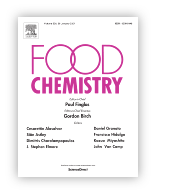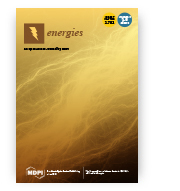Fruit tree leaves as unconventional and valuable source of chlorophyll and carotenoid compounds determined by liquid chromatography-photodiode-quadrupole/time of flight-electrospray ionization-mass spectrometry (LC-PDA-qTof-ESI-MS)
Aneta Wojdyło, Paulina Nowicka, Karolina Tkacz, Igor Turkiewicz
Food Chemistry
 This study focused on the identification (by LC-PDA-qTof-ESI-MS) and quantification (by UPLC-PDA) of isoprenoids of the fruit tree leaves (FTL) of commonly consumed fruits: apple, pears, quince, apricot, peach, plums, sweet and sour cherry. The FTL were collected at 2 time points: after tree blooming and after fruit collection. In FTL 7 carotenoids and 16 chlorophylls were identified, but the number of labeled chlorophyll compounds depended on the species. FTL of apple, sour cherry and apricot were identified as the best sources of chlorophylls (mean 404.8, 388.7 and 364.5 mg/100 g dw, respectively) and sweet and sour cherry leaves as the best sources of carotenoids (831.4 and 1162.0 mg/100 g dw, respectively). A lower content of chlorophylls and carotenoids, but not significantly, was detected in leaves after autumn collection of fruits compared to leaves collected after blooming. Fruit tree leaves are good material for isolation of chlorophylls and carotenoids for application in cosmetics, pharmaceuticals or in the food industry, e.g. production of beverages or puree.
This study focused on the identification (by LC-PDA-qTof-ESI-MS) and quantification (by UPLC-PDA) of isoprenoids of the fruit tree leaves (FTL) of commonly consumed fruits: apple, pears, quince, apricot, peach, plums, sweet and sour cherry. The FTL were collected at 2 time points: after tree blooming and after fruit collection. In FTL 7 carotenoids and 16 chlorophylls were identified, but the number of labeled chlorophyll compounds depended on the species. FTL of apple, sour cherry and apricot were identified as the best sources of chlorophylls (mean 404.8, 388.7 and 364.5 mg/100 g dw, respectively) and sweet and sour cherry leaves as the best sources of carotenoids (831.4 and 1162.0 mg/100 g dw, respectively). A lower content of chlorophylls and carotenoids, but not significantly, was detected in leaves after autumn collection of fruits compared to leaves collected after blooming. Fruit tree leaves are good material for isolation of chlorophylls and carotenoids for application in cosmetics, pharmaceuticals or in the food industry, e.g. production of beverages or puree.
10.1016/j.foodchem.2021.129156
Modeling of CO Accumulation in the Headspace of the Bioreactor during Organic Waste Composting
Karolina Sobieraj, Sylwia Stegenta-Dąbrowska, Jacek A. Koziel, Andrzej Białowiec
Energies
 Advanced technologies call for composting indoors for minimized impact on the surrounding environment. However, enclosing compost piles inside halls may cause the accumulation of toxic pollutants, including carbon monoxide (CO). Thus, there is a need to assess the occupational risk to workers that can be exposed to CO concentrations > 300 ppm at the initial stage of the process. The objectives were to (1) develop a model of CO accumulation in the headspace of the bioreactor during organic waste composting and (2) assess the impact of headspace ventilation of enclosed compost. The maximum allowable CO level inside the bioreactor headspace for potential short-term occupational exposure up to 10 min was 100 ppm. The composting was modeled in the horizontal static reactor over 14 days in seven scenarios, differing in the ratio of headspace-to-waste volumes (H:W) (4:1, 3:1, 2:1, 1:1, 1:2, 1:3, 1:4). Headspace CO concentration exceeded 100 ppm in each variant with the maximum value of 36.1% without ventilation and 3.2% with the daily release of accumulated CO. The airflow necessary to maintain CO < 100 ppmv should be at least 7.15 m3·(h·Mg w.m.)−1. The H:W > 4:1 and the height of compost pile < 1 m were less susceptible to CO accumulation.
Advanced technologies call for composting indoors for minimized impact on the surrounding environment. However, enclosing compost piles inside halls may cause the accumulation of toxic pollutants, including carbon monoxide (CO). Thus, there is a need to assess the occupational risk to workers that can be exposed to CO concentrations > 300 ppm at the initial stage of the process. The objectives were to (1) develop a model of CO accumulation in the headspace of the bioreactor during organic waste composting and (2) assess the impact of headspace ventilation of enclosed compost. The maximum allowable CO level inside the bioreactor headspace for potential short-term occupational exposure up to 10 min was 100 ppm. The composting was modeled in the horizontal static reactor over 14 days in seven scenarios, differing in the ratio of headspace-to-waste volumes (H:W) (4:1, 3:1, 2:1, 1:1, 1:2, 1:3, 1:4). Headspace CO concentration exceeded 100 ppm in each variant with the maximum value of 36.1% without ventilation and 3.2% with the daily release of accumulated CO. The airflow necessary to maintain CO < 100 ppmv should be at least 7.15 m3·(h·Mg w.m.)−1. The H:W > 4:1 and the height of compost pile < 1 m were less susceptible to CO accumulation.
10.3390/en14051367









